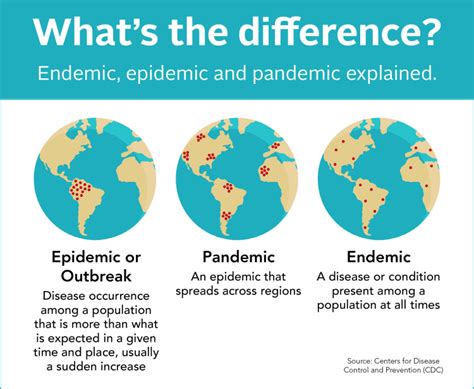Endemic Or Epidemic

In the vast landscape of public health and disease control, the terms endemic and epidemic hold significant importance. These concepts help us understand the patterns and behaviors of diseases, guiding public health officials, researchers, and healthcare providers in their efforts to mitigate and manage health crises. As we delve into the intricate world of disease dynamics, we uncover the unique characteristics that define endemic and epidemic situations, each posing distinct challenges and requiring tailored strategies for prevention and control.
The Endemic Landscape: A Stable Presence

An endemic disease is a constant presence within a specific geographic region or population group. It maintains a stable prevalence over time, with a consistent pattern of occurrence. This stability arises from a delicate balance between the disease, the host population, and the environment. Endemic diseases often have established patterns of transmission and a predictable impact on the community.
Examples of Endemic Diseases
- Malaria: A mosquito-borne disease that is endemic in many tropical and subtropical regions, causing an estimated 229 million cases and 602,000 deaths globally in 2021.
- Tuberculosis: A bacterial infection primarily affecting the lungs, with about 10 million new cases and 1.5 million deaths worldwide in 2020.
- Dengue Fever: Another mosquito-borne disease, endemic in over 100 countries, with an estimated 390 million infections annually.
While these diseases are prevalent in their respective regions, they do not typically cause widespread panic or emergency situations. The local population and healthcare systems are often adapted to manage these endemic diseases, with established prevention and treatment strategies in place.
| Disease | Endemic Region | Estimated Cases (Annual) |
|---|---|---|
| Malaria | Tropical and Subtropical Regions | 229 million |
| Tuberculosis | Global, with highest burden in South-East Asia and Africa | 10 million new cases |
| Dengue Fever | Over 100 countries, mostly tropical | 390 million infections |

The Epidemic Surge: A Sudden, Rapid Rise

An epidemic, on the other hand, is a sudden increase in the number of disease cases, typically in a specific region or population, over a limited period. Unlike endemics, epidemics are characterized by a rapid spread, often surpassing the capacity of the healthcare system to respond effectively. The reasons for this surge can vary, from changes in environmental conditions to the introduction of a new pathogen or the emergence of a more virulent strain.
Understanding Epidemic Dynamics
Epidemics often follow a distinct pattern. They begin with a small number of cases, which then rapidly increase, potentially leading to a situation where the healthcare system is overwhelmed. The peak of the epidemic is reached when the number of new cases begins to decline, often due to interventions, community immunity, or a natural limit to the pathogen’s spread. Finally, the epidemic subsides, and the disease returns to its baseline or endemic state.
The impact of an epidemic can be far-reaching, affecting not only the health of the population but also social and economic systems. The swift response of public health authorities and the implementation of effective control measures are crucial to mitigating the impact and preventing the spread.
Notable Epidemic Events
- The 1918 Influenza Pandemic: One of the deadliest pandemics in history, resulting in an estimated 50-100 million deaths worldwide.
- Ebola Outbreaks: Several Ebola outbreaks in West Africa (2014-2016) and the Democratic Republic of Congo (2018-2020) highlighted the challenges of controlling highly contagious diseases.
- COVID-19 Pandemic: The ongoing global health crisis caused by the SARS-CoV-2 virus, leading to over 6 million deaths and unprecedented global health measures.
These epidemics and pandemics have shaped our understanding of disease control and highlighted the importance of preparedness, rapid response, and international collaboration.
| Epidemic/Pandemic | Disease | Period | Impact |
|---|---|---|---|
| 1918 Influenza Pandemic | Influenza | 1918-1920 | 50-100 million deaths |
| Ebola Outbreaks | Ebola Virus Disease | 2014-2020 | Over 11,000 deaths in West Africa |
| COVID-19 Pandemic | COVID-19 | 2020-Ongoing | Over 6 million deaths worldwide |
Conclusion: Navigating the Disease Landscape
The distinction between endemic and epidemic diseases is a critical concept in public health. While endemic diseases are a stable presence that healthcare systems can manage effectively, epidemics and pandemics present urgent challenges that require immediate action and innovative solutions. Understanding these concepts and their implications is vital for developing effective strategies to protect public health and mitigate the impact of disease outbreaks.
What factors contribute to a disease becoming epidemic or pandemic?
+Several factors can contribute to a disease’s transition from endemic to epidemic or pandemic. These include changes in environmental conditions, the introduction of a new pathogen or strain, population movement and density, and the lack of community immunity or effective prevention strategies. The rapid spread and high transmissibility of a disease are key indicators of an epidemic or pandemic.
How do public health authorities respond to an epidemic?
+Public health authorities implement a range of strategies to control and mitigate epidemics. These include surveillance and monitoring to track the spread, contact tracing to identify potential cases, isolation and quarantine measures, the implementation of social distancing and other non-pharmaceutical interventions, and, when available, the use of vaccines and specific treatments. Communication and community engagement are also vital to ensure compliance and reduce the impact.
Can endemic diseases become more severe or widespread over time?
+While endemic diseases are generally well-managed and have established control measures, they can sometimes evolve or mutate, leading to more severe forms or increased transmissibility. This can result in local outbreaks or, in some cases, contribute to the emergence of new epidemic strains. Regular surveillance and research are crucial to monitor these diseases and ensure effective control measures remain in place.



